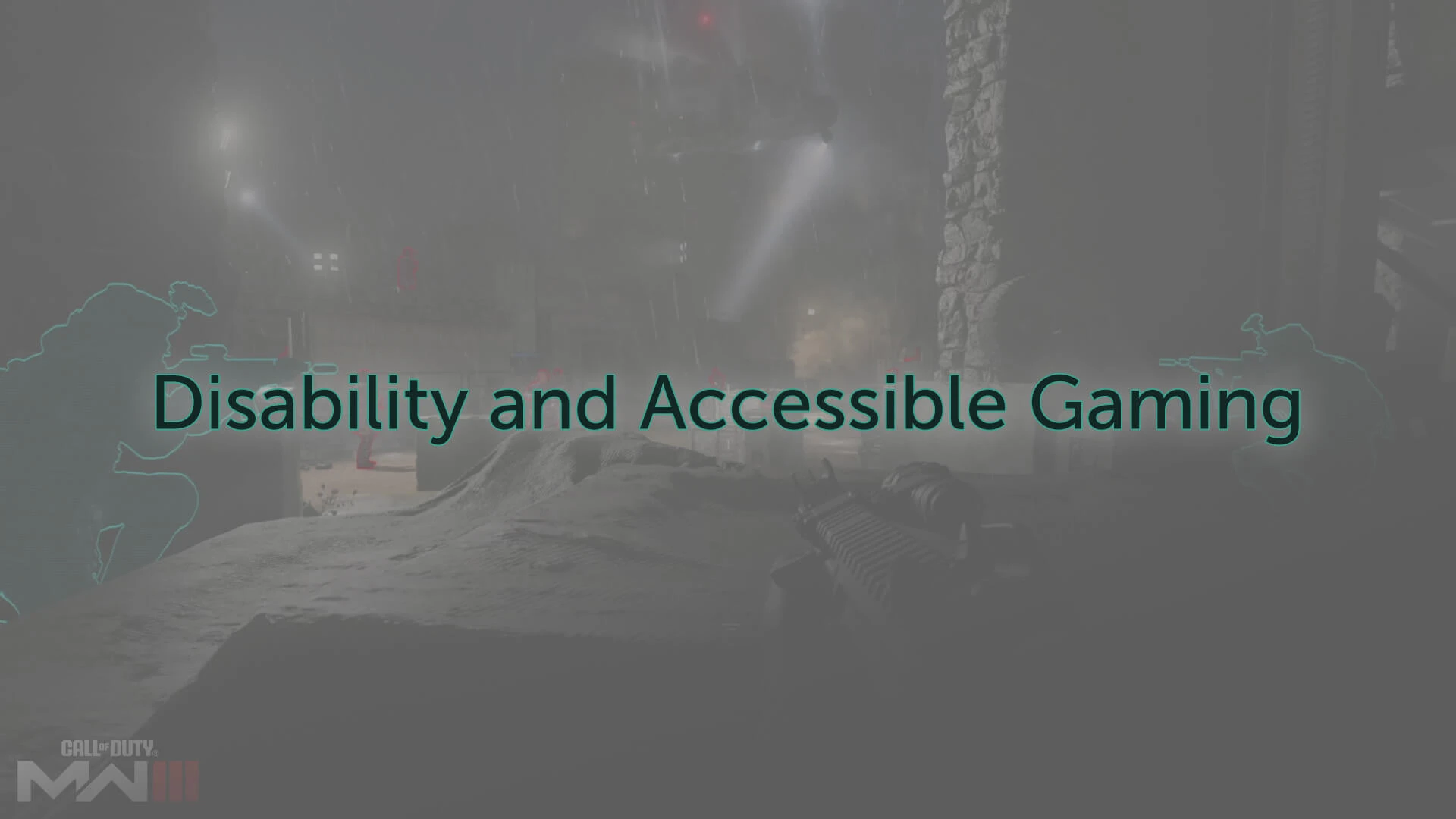
Image credit: Background image credit: Activision
Originally appeared in LinkedIn AccessABILITY
Every day, billions of people play video games worldwide, and a sizable portion of them activate accessibility features. This isn't just about disability inclusion, although that's vitally important. Many gamers, regardless of ability, choose to utilize accessibility options to enhance their gameplay experience.
This article is based on my takeaways from SXSW 2024 and the session "Designing Accessible Games for All to Play". The speakers were: Adrian Ledda, Head of Inclusive Game Design at Activision Blizzard, and Steven Weitz, Director of Professional Development at AbleGamers.
What do we mean by disabilities? Defining what disabilities are is a vast and varied thing. Typically, we consider larger buckets of disabilities that include things like physical, mental, age related, temporary modality disabilities, etc. But simply defining what a disability is does not define how someone with a disability can use your product or service, or even how you should refine your offering to cater to “users with accessibility needs” in the same way as what would be considered a “typical consumer/user.”
When we focus on gaming, and technology in general, it’s something that can be used to help ensure that the playing field is somewhat leveled for all players. This doesn’t mean that there should be an “easy mode” for those with disabilities or special needs. It does however mean that accommodations should be considered, and settings available, to modify the game play based on the user's needs.
While a disability can be unique to an individual, accessibility can be unique to the product. In other words, there will never be a solution that addresses every need, but based on the product, modifications can be made to make it “as usable as possible by all users”.
For instance, in the Call of Duty game, high contrast mode makes it clearer to users who may be an enemy or an ally based on the thickness of borders drawn around the characters. The Activision/Blizzard and Call of Duty websites explain the accessibility features of their games, but they also allow for input from their users. Based on the feedback that they have received, they’ve made additional accessibility feature patches over the years. For example, a user that suffered an injury in the military that can only hear out of one ear, or has “1/2 deafness”, found it difficult to play using the standard audio because understanding the state of game play was highly reliant on the ability to hear and understand the stereo audio field. The user submission led to the development and inclusion of the mono audio option within the game.
100% accessibility is and amazing end-goal, a noble goal, however not a very realistic goal. It's important to do what you can to ensure that your products and services are accessible as they can be, but also continue to pursue improving accessibility as we iterate newer versions and patches.
We also need to be more open to learning from our failures. Adrian once functioned as a character designer on Spyro the Dragon. During the development he realized there were no subtitles. He knew that something was missing, and he wanted to express his opinions to leadership, but he also wasn’t well versed enough to properly convey his concerns. The game was released to rave reviews, but it was also panned for missing subtitles and thereby excluding a subset of their user base. They moved to add the subtitles to the game and in the end released them as a software patch. This resulted in a favorable output, but simply patching our mistakes isn't enough. We need to consider accessibility from the beginning. For instance, when Adrian and his team were developing the new Crash Bandicoot game, they reflected on past mistakes and considered accessibility from the very beginning.
Making a Difference
Advocates for accessibility in video games, like AbleGamers, emphasize some high-level principles. There has to be a goal. That goal is most commonly that we must continue to challenge ourselves to make things inclusive and accessible. And we need to focus on achieving that goal. As such we must set a requirement for ourselves, a requirement that we should test our products and services using people with disabilities. However, this presents a challenge. Companies and developers often feel overwhelmed by the thought of accommodating everyone, every disability, every time. This simply isn't necessary or feasible.
Many developers and designers nationwide have expressed a desire for clear guidelines. Existing guidelines like WCAG are helpful for digital products, but they don't perfectly address game-specific aspects like gameplay mechanics and haptic feedback. This need has led to the development of resources like the APX (Accessible Player Experiences) design patterns. These design patterns are freely available resources for game development and design teams. They offer practical solutions for creating inclusive gameplay experiences and are used in training programs for developers, including those at Activision.
Driving Innovation
The challenge of making inclusive and accessible games can be a surprising source of innovation. It forces development teams to think outside the box and consider the needs of a wider audience. This collaborative effort can spark new ideas and features that benefit all players, not just those with disabilities.
Activision's empathy exercise is a prime example. By requiring developers to play Call of Duty with the sound off, they directly experienced the challenges faced by players with hearing impairments. This not only fostered a deeper understanding of accessibility needs but likely sparked creative solutions for improved audio cues or alternative ways to convey information. Imagine the possibilities – a new game mechanic designed specifically for players with limited dexterity that ends up being embraced by everyone for its strategic depth or unique playstyle. Accessibility features like customizable menus and colorblind modes can inspire simpler and more intuitive interfaces that benefit everyone, not just those who need them. Developing features to assist players with visual impairments might lead to innovative uses of AI for in-game tutorials or dynamic difficulty adjustments.
The potential for innovation goes beyond gameplay. Accessible design principles can lead to richer narratives that resonate with a more diverse audience. Imagine a story element that uses visual cues alongside audio descriptions, creating a more immersive experience for everyone. By actively seeking feedback from players with disabilities, developers can tap into a vast pool of creative ideas and perspectives. This two-way communication can fuel innovation across the entire development process, leading to richer stories and a more engaged community.
There's also a clear market opportunity. The statistics show that there are approximately 49.7 million players (and potential players) with disabilities in the US alone. Similar statistics exist around the globe. There's a massive potential audience of players with disabilities who are eager for accessible experiences. By embracing accessibility as a driver of innovation, you're not just doing the right thing; you're opening the door to a significant and untapped market. This approach creates a win-win situation, fostering a more inclusive gaming experience while expanding your player base.
Captions
Captions have emerged as a powerful tool for fostering accessibility in video games. Primarily benefiting players who are deaf or hard of hearing, captions display on-screen text that corresponds to spoken dialogue. This ensures all players can follow the story and understand the game's content. But the value of captions extends far beyond this core function.
Modern captions often include sound descriptions alongside dialogue, creating a richer experience for everyone. Imagine a visually impaired player enjoying the atmosphere of a bustling marketplace through detailed audio descriptions woven into the captions. This commitment to inclusivity levels the playing field for all users.
The widespread adoption of captions across the gaming industry highlights this. Statistics show a significant percentage of players, even those without hearing impairments, choose to keep captions enabled. This reveals the broader value of captions as a feature that enhances the gaming experience for a wider audience.
Captions benefit players with learning disabilities or cognitive impairments who might find it easier to process information visually. They cater to gamers who prefer to read along with the audio, or those who might be in situations where they can't have the sound on. Ultimately, captions demonstrate how accessibility features can not only expand a game's reach but also improve the overall experience for a diverse player base.
Modes of Play
There's often confusion surrounding accessibility in gaming. Some mistakenly equate it with "easy mode," when accessibility is about much more. As mentioned earlier, disabilities encompass visual impairments, hearing difficulties, cognitive differences, and more. Accessibility features cater to these diverse needs, ensuring everyone can enjoy the game.
Games like Celeste [https://www.celestegame.com], a challenging platformer, demonstrate the distinction between difficulty and accessibility. Celeste offers an "assist mode" designed for accessibility. However, the implementation highlights a potential pitfall – discouraging players from using it with disclaimers emphasizing the intended difficulty. While every developer wants players to experience their vision, true accessibility prioritizes the player and their needs.
Another area for improvement is the terminology surrounding game modes. Often, "story mode" is mistakenly seen as a difficulty setting, leading to confusion. In some games like God of War, story mode still includes combat, but with adjustments. Here, clear communication during mode selection is crucial. Players deserve to understand exactly what each mode entails, avoiding the expectation of a "no combat" experience when that's not the case. This wouldn't eliminate combat, but narrate it, allowing them to follow the action.
Clear communication is key. Confusing options like "story mode" for accessibility features can lead to disappointment. When designing for accessibility, ask yourself: "Are we unintentionally creating barriers for players?" By prioritizing clear communication and comprehensive accessibility features, we can ensure everyone enjoys the thrill of the game, not the frustration of navigating unclear options.
In Summary
Accessibility features in games, initially designed for disabled individuals, benefit all players by enhancing gameplay experiences and expanding the potential player base. Despite misconceptions, including accessibility features is financially beneficial and essential for inclusive design, as well as promoting gaming enjoyment for individuals with a wide range of abilities.
Useful Resources
The Web Content Accessibility Guidelines (WCAG) are a set of technical standards developed by the World Wide Web Consortium (W3C) that help make web content more accessible to people with disabilities. https://www.w3.org/TR/WCAG22/
Google’s inclusive marketing aims to eliminate biases and increase representation in all stages of the creative process to better reflect diverse perspectives. Check out the guides. https://all-in.withgoogle.com/


